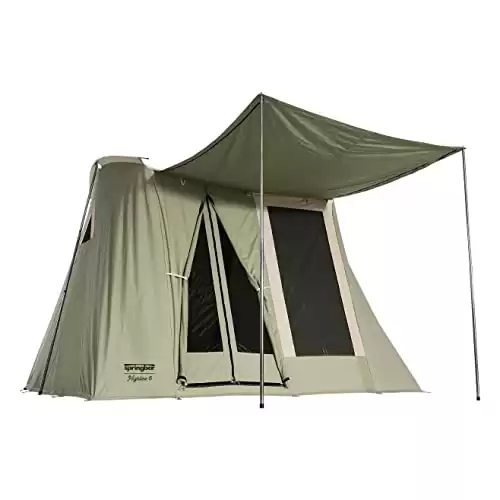Springbar is an iconic brand in the canvas tent world. Originally designed by Jack Kirkham in the 1960s, it’s one of the few American brands that still manufactures tents in the U.S.
Springbar Canvas (aka Kirkhams) has a full line of tents that are hand-sewn in Salt Lake City with U.S.-sourced poles and stakes.
Many will use a Springbar for family camping, hunting, base camps, festivals, and anywhere you need a high-quality and weather-resistant tent.
Springbar is #2 on my list of best canvas tents.

I have over 15 articles on canvas tents. Get everything you need to know, including discount codes.
Description: The classic Springbar U.S. | Description: Disclosure: I write real reviews and do not accept free products. Links on this website may be affiliate links where I earn a small commission at no additional cost to you. | Description:
Brands included: Springbar, Kodiak, White Duck, Teton Sports |
Disclosure: I write real reviews and do not accept free products. Links on this website may be affiliate links where I earn a small commission at no additional cost to you.
- Up to 15% off (and Avoid Amazon)
- Honest Reviews
- Ask Questions
- How to NOT Destroy Your Tent
Brands included: Springbar, Kodiak, White Duck, Teton Sports
I’ve used a Springbar for casual weekend camping, long-term camping, and as a basecamp for working remotely (learn more about that here).
You may not be using it for the same reasons I am, but the benefits (and some negatives) will definitely cross over to your use.

I purchased my Springbar in May 2021. I’ve had it for about 2.5 years and tested it often while working remotely and camping.
It’s seen heavy rain, snow, ferocious blown sand, and more.
No matter which canvas tent you go with (read Kodiak vs Springbar here), make sure to check out my new post about the best hammer for pounding in and removing the large 12 inch stakes!

Canvas Tents Overview
Let me be clear from the outset… you don’t get a canvas tent for its lightweight or convenience. It’s not for that overnight trip with friends. As long as you know that, you will better appreciate what a Springbar or any canvas tent offers.
I had never heard of canvas tents until I began on this journey to look for an “office” tent since I work remotely, but wasn’t very productive on the road.
They aren’t hard to set up, but they do take time… especially with 12 inch stakes.
There are basically three canvas cabin-tent brands to choose from: Springbar or Kodiak or WhiteDuck.







